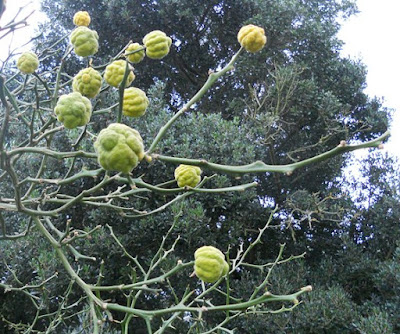The Bitter Orange of the East
I missed the fragrant flowers and attractive autumn foliage
on this one but with all the leaves gone even I can’t miss the warty, down-covered
fruits.
It’s Citrus trifoliata,
the Japanese Bitter Orange. I’m assuming it has leaves divided into three but
as you can see in the next photo there is nothing but stem and fruit at the
moment. Bitter Orange is well known for its thorns, which can be seen in this picture.
Bitter Orange belongs to the plant family Rutaceae, along
with other citrus and boronias. You may be more familiar with this species when
something goes awry at the base of your edible citrus; it’s widely used a
rootstock, at least in the UK. It’s also been called Poncirus trifoliata, but these days we consider it a true Citrus, even though it sits out on its
own a little within this genus. It certainly interbreeds successfully with
other citruses, resulting in the following self-evident crosses (thanks Citrus Pages):
citranges, citrumelos, citrandarins, citremons, citradias and citrumquats. For
more on what is citrus and Citrus,
see my post
earlier this year.
The fruit of the Bitter Orange, called ‘karatachi’ in Japan,
won’t kill you but I gather it’s…bitter. That part of the name is correct. You
can make marmalade from them, or candy the peel as a spice. In China the fruit
has numerous uses in traditional medicine. Just don’t expect to see them soon
on your western supermarket shelves.
There is nothing quite like the Japanese Bitter Orange in Citrus, and when it was in its own genus Poncirus there was one species only. Despite the common name it grows naturally in northern
China and Korea. As with a bunch of other geographically misnamed Chinese
plants it came to Europe via Japan. The most famous of these is perhaps the
Japanese Pagoda Tree, Styphnolobium (previously Sophora) japonicum, which has a misleading common and scientific name. The most
famous specimen of Japanese Pagoda Tree is perhaps this one, in Kew Gardens,
about to turn 250 next year (it’s one of Kew’s ‘Old Lions’, planted in 1762)
The easiest place to find a Bitter Orange at Kew Gardens is not
far away, near the drinking fountain just behind the Orangery. I walk past it
every day on the way to my office but only this morning did I notice its fruit,
and indeed its very existence. That’s the great thing about working in a
botanic garden, particularly one with 30,000 potential surprises.
Images: The Japanese
Bitter Orange snaps are mine and taken yesterday. The Japanese Pagoda Tree is
via Creative Commons and Flickr, and is a photo by Chris Guise (1967geezer) -
my images of this specimen just don’t do it justice!




Comments